Fists of Fury

This story appears in the Oct. 8, 2018, issue of Sports Illustrated. For more great storytelling and in-depth analysis, subscribe to the magazine—and get up to 94% off the cover price. Click here for more.
Start with the image, a still life of protest. It captures a vital moment in history, yet its meaning evolves, as time measures what has—and has not—been learned.
It tells the story of a battle fought, in a war neither won nor lost, but ongoing. Of a place and a time, not so different from here and now. Of sports and division, it was fifty years ago this month. “Fifty years! Can you believe that?” says Tommie Smith, a man of 24 in the image, a much older man of 74 today. Fifty years.
In the scene, Smith stands on the top of the Olympic podium, the number 1 painted beneath his feet, which are purposefully sheathed only in black socks, with a single black Puma sneaker also perched on the platform. He is a black man wearing a black scarf beneath his red, white and blue USA sweats, and a black glove on his right hand, which is thrust skyward, his arm so straight, it looks as if he is trying to reach into the grey overcast and bring rain. This was on the evening of Oct. 16, 1968, in Mexico City. A Wednesday.
Many Americans saw this scene on square black-and-white televisions while eating dinner. Smith had won the gold medal in the 200 meters. It hangs from his neck as “The Star-Spangled Banner” plays. His head is bowed, his face intense. Behind him, facing the medalists’ flags, is bronze medalist John Carlos of the U.S., then 23. The two men were training partners of a kind in California, but not close friends. Carlos is also shoeless in black socks, a sneaker on the platform. Beads hang from his neck, behind his medal. He has a black glove on his left hand, which is raised. His arm is slightly bent, his pose more casual than Smith’s, but no less forceful and eloquent.
There is a third man in the image, silver medalist Peter Norman, a 26-year-old Australian. He is wearing the green uniform of his country and, like Smith and Carlos, a white button pinned to his chest. Norman is looking up at the flags, smiling. Fifty years.
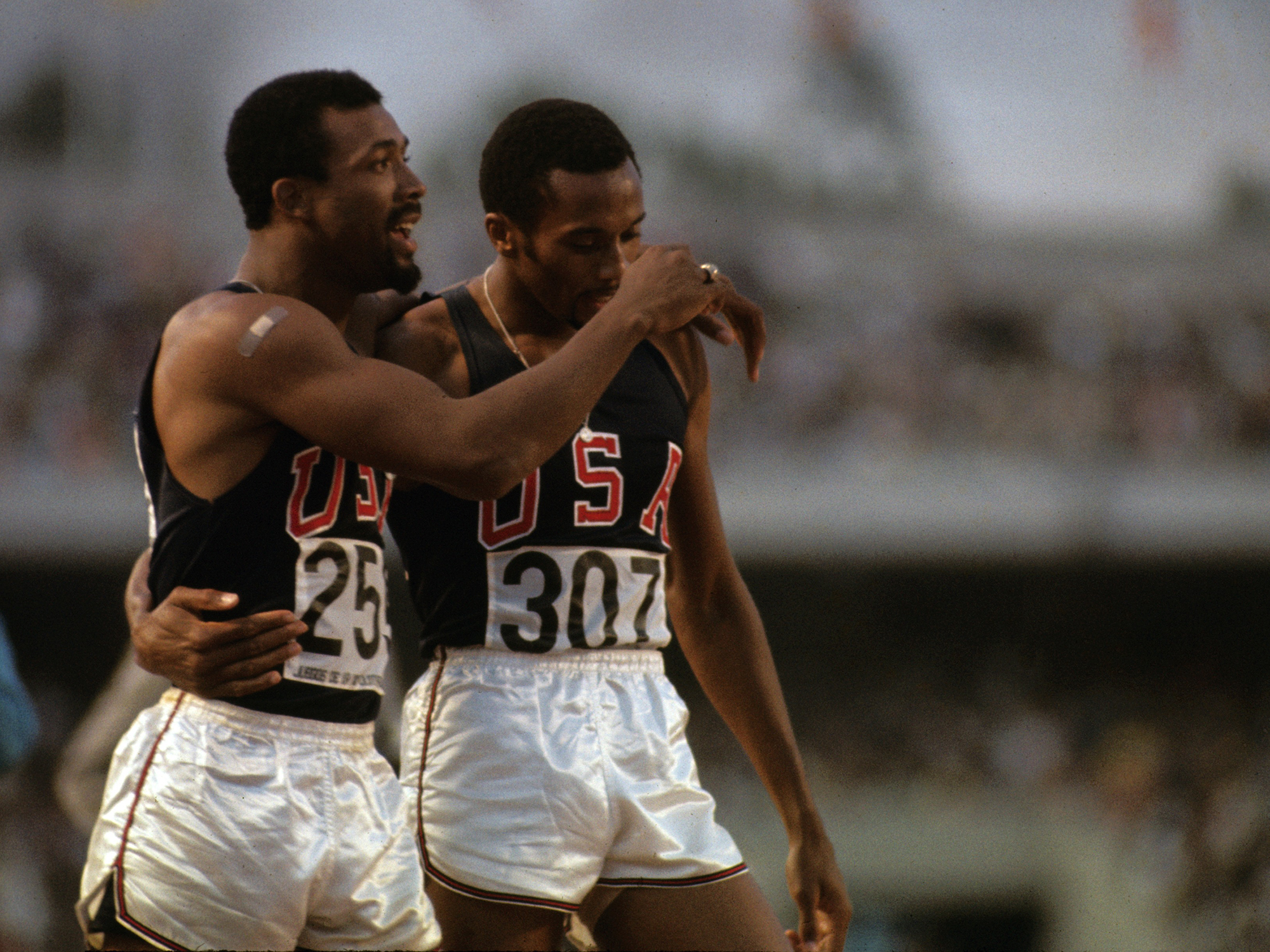
That is the singular moment, one of the most iconic—and important and controversial—in sports history. This is a story about that moment, but just as much about the moments that followed, laid end-to-end, repeated, until they span months and years and decades, and encompass lives and legacies. Smith and Carlos were young black men protesting racial inequality, using the platform of the ceremonial playing of their national anthem at a sports event. Where they raised their fists, a half century later Colin Kaepernick would take a knee. “We’re trying to recapture terrain that we thought was once conquered,” says Harry Edwards, the septuagenarian sports sociologist who as a 25-year-old instructor in 1968 organized the movement that led to Smith’s and Carlos’s protest.
The moment defines Smith and Carlos, as Kaepernick’s defines him, and always will. It extracted a cost—opportunity lost, money never earned, families tested and broken. They were heroes to some, pariahs to others, lauded and threatened and belittled. Smith, as sweet a mover as ever set foot on a track (Lord, to have seen him race Usain Bolt), ran a few races after the Olympic final. Carlos ran until 1970, ranking first in the world in both the 100 and 200 meters.
Both men only found footing in society many years after Mexico City and, ever so gradually, gained acceptance as leaders. In 2005, a 22-foot statue depicting the scene on the medal stand was dedicated at San Jose State, where both had been students and competed. Three years later ESPN awarded Smith and Carlos the Arthur Ashe Courage Award, and in September 2016 they were recognized at the White House by President Obama with members of the ’16 U.S. Olympic team. Yet now they grapple with the state of race relations in their country, which some days makes them wonder what they accomplished 50 years ago. “Many struggles are not final victories,” Edwards says.
And each wonders alone. Both men have family and friends and the hard-earned respect of millions, but they do not have each other. Smith is a sharecropper’s son, raised picking cotton in California’s San Joaquin Valley, serious and dutiful. Carlos was born and raised in Harlem, with the soul of a hustler. They have never been close. “Oil and water,” says Smith’s wife, Delois. The protest and all that followed did not bring them closer.
Smith and Carlos see each other on occasion—at various reunions of the 1968 Olympic team, or for paid speaking gigs. They are a set of two, keen to experiences that no other human—except perhaps Kaepernick, who has met with both men—can understand. Yet they are not a pair. They are one, and one.
It is no simple matter to gain access to Smith or Carlos to talk to them about their story. They know how its meaning has evolved, and how it is acutely relevant. But their reticence is understandable. Both are weary. Carlos is as game as ever to take on the system (you’ll see); Smith, as ever, is more cautious (you’ll see).
I started asking in late February, with emails and calls that went unanswered. I asked mutual friends to help. Nothing. Smith and Carlos speak in public regularly and sometimes together, but rarely these days sit for media interviews.
In late May, I received a reply from Delois, who handles most of Tommie’s affairs. (She is his third wife; they have been together for 21 years.) The email: “Call me tomorrow,” and a phone number. When I called, Delois talked about the many times her husband had signed the cover of the May 22, 1967, issue of Sports Illustrated, which featured the 22-year-old Smith uncoiling from starting blocks in gold sweats, next to the headline: blazing quarter-miler. (He did not enter the 400 in Mexico City.) She also asked, “Is this a paid interview?” I told her that it was not. “I am going to grant you this interview with Dr. Smith,” Delois then said, cheerfully.
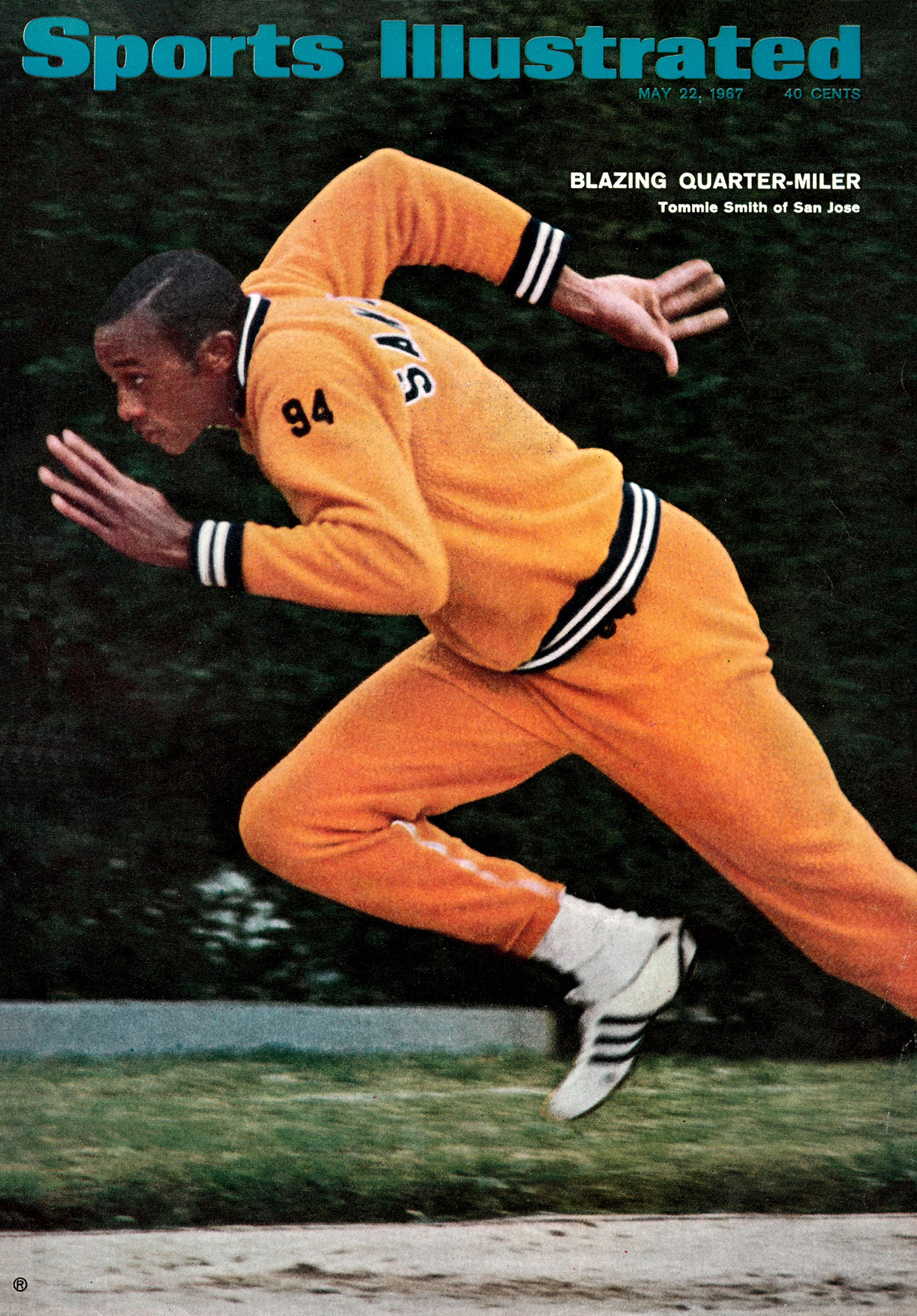
Tommie Smith has lived in a modest, two-story brick house in Stone Mountain, Ga., since 2005, when he retired after 27 years as a teacher and coach at Santa Monica (Calif.) College. We talked in his basement, which is a staggering monument to not just the evening of Oct. 16, 1968, but also to his remarkable (and remarkably short) track career, to his life, to a vital era in track and field, to the Olympics and to activism. The room is alive with memories. An Olympic flag, swiped by Smith from the Mexico City Olympic Stadium before the protest, decorated with the signatures of U.S. teammates Jim Hines, Al Oerter, Jim Ryun and others. A framed Newsweek cover from ’68 with the headline, the angry black athlete. A picture of his childhood home in rural Lemoore, Calif. Another of his junior high basketball team, with Smith towering over his teammates as a 6' 2" eighth-grader. Dozens of black-and-white action photos of Smith setting some of his 11 world records between ’66 and ’68. And several shots of the medal stand protest, some signed by Carlos and Norman.
Smith settles into a lounge chair and leans forward, engaged. “I don’t talk to everybody,” he says, “because I don’t want to fight what’s going on now in the country. I only want to talk about my belief in what I was doing.” When, in the course of a two-hour interview, the subject turns to today’s racial climate, Smith speaks slowly and carefully. He knows who he is and understands the power of his name. “I have to make all my words count,” he says. “Have things changed in fifty years? Not as much as I hoped they would. At times it’s as bad or worse than it was in the ’60s because there are more things to become agitated about. And the people to fight those negatives are fewer because black folks don’t have that leadership, black or white, like Dr. King or the Kennedys.”
Minutes later he resets, seeking an uplifting turn: “It’s moving in a positive direction.”
When I ask him if he approves of President Trump (and his policies), Smith says, “His tenacity, but not where it’s going. Nobody thought he would be here, so you have to admire. . . .” Smith stops and points his finger at me. “Now don’t you say Tommie Smith likes Trump. Any leader needs to be strong, but not to the point where he becomes a tyrant. Like Putin. Putin is a tyrant.”
Carlos lives 20 minutes south of Smith. Fifty years after sharing the podium, they could shop at the same Kroger and both fly out of Hartsfield. That has not brought them closer. “People said we would be joined at the hip,” says Smith. “That has not been the case. We’re totally different people. I’m quiet and reclusive; he says what’s on his mind. I’m an introvert; he’s an extrovert. I count to 10 before I throw a rock and then maybe I throw a Wiffle ball instead. He throws the rock.”
Between February and late June, I called Carlos half a dozen times and sent an equal number of text messages. Colleagues who know Carlos told me that he was finished doing interviews. Forever. After leaving Smith’s house, I made one last call, and Carlos answered. Then he threw some rocks.
“Tim!” he shouted into his phone. “What the hell do I have to do to get you to stop calling me? I’ve been talking about this s--- for fifty years, and ain’t nothing changed since Mexico City in 1968. Nothing! I’ve spoken and spoken and spoken, and it ain’t gonna make no difference. It ain’t enough. I could die and come back in another life, and things would be the same. You have to agree with that.”
I suggest that a story might amplify his message. “You write your article in Sports Illustrated,” says Carlos. “You think that evil is defeated because people read that s---? That ain’t gonna happen, my brother.”
At 73, John Wesley Carlos is a proud and passionate man, unfiltered. A few weeks later I talked with the oldest of his three children, Kimme, who is 52. “My father is a private person,” she said. “But if you do talk with him, he will speak from the heart. It’s all on the table.” I spoke with John for 17 minutes. His initial response—it ain’t gonna make no difference—sounds at first like resignation, but it’s actually anger. Where Smith is careful and largely muted on social media, Carlos posts and shares furiously on two Facebook pages. Where Smith assiduously avoids the bullring of public discourse, Carlos seeks it, on his terms, advocating change. Last May he posted a 347-word criticism of the NFL’s anthem policy and the President’s support of that policy.
I asked Carlos why he still fights. “Look at what you have in the White House,” says Carlos. “That’s the outer layer of America. That’s the President, supplying his base. He called young black men sons of bitches for kneeling. Sons of bitches! He said they weren’t respecting the military. What did he ever do in the military? What did any of his children do in the military? And then you’ve got police officers out there shooting young black men, and nobody is prosecuted. Nobody is sent to jail. It’s the same b------- today that it was fifty years ago.”
Carlos was not impolite in this exchange. He was full of life and fury. Only on the subject of Smith did he mellow ever so slightly, shifting from prose to poetry. “You look at Dr. King and Malcolm X,” says Carlos. “Each of those men had different methodologies for dealing with the complexities of society. But both came to the fight with courage. When the dust settles, O.K., Tommie Smith and I walk together for eternity, but we never got the chance to be together.”
With that, Carlos ended our conversation, but for this: He added suddenly, “Hey, Tim. I’m done. That’s all I got. O.K.? That’s it. O.K.?”
O.K.
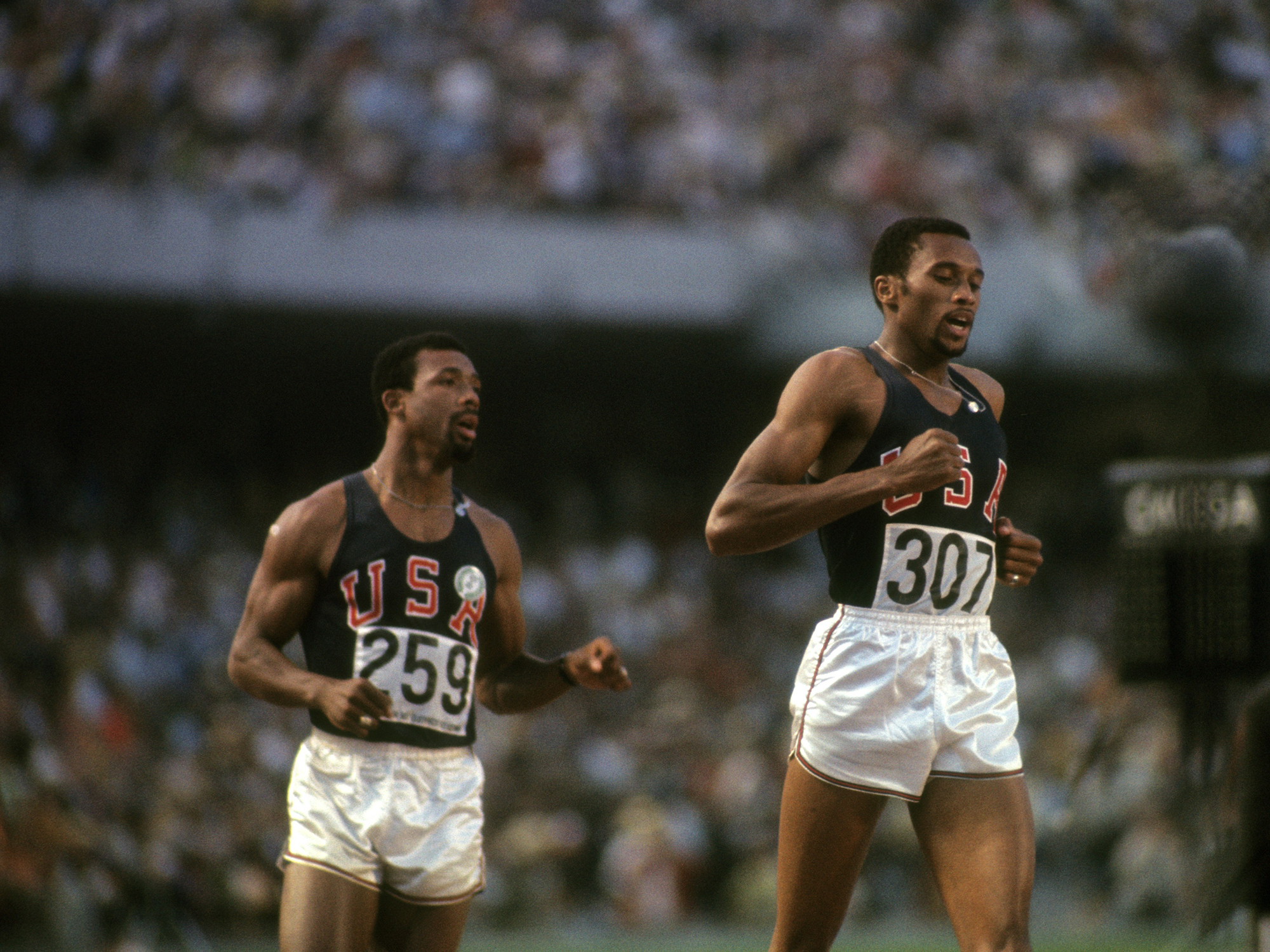
The Mexico City protest was not spontaneous. It was part of an 18-month movement organized by Edwards. He had been an athlete at San Jose State, and that is where he first began organizing student protests. A boycott of the 1968 Olympics by black U.S. athletes had been discussed privately, and the idea went public after Smith won two medals at the World University Games in Tokyo in September ’67, when Smith affirmed the possibility to a Japanese reporter. In late November the vague boycott talks coalesced into the formation, under Edwards, of the Olympic Project for Human Rights (OPHR), which made four demands: the expulsion of apartheid South Africa and Rhodesia from the Olympics; the removal of IOC president Avery Brundage of the U.S., who had vigorously supported the awarding of the 1936 Games to Hitler’s Germany; the hiring of more black coaches at college sports programs; and the restoration of Muhammad Ali’s heavyweight championship title (which had been stripped in April ’67 after he refused induction into the Army).
In late 1967, Smith and his San Jose State teammate Lee Evans, a 400‑meter runner, committed to the boycott. According to an SI story that December, Smith said to Evans as they walked out of Smith’s apartment, “All I hope is that this [boycott] does some good, that it doesn’t create any chaos.”
But America was already ablaze in chaos. In the summer of 1967, there were race riots in Detroit and Newark. In January ’68, the Tet offensive fueled antiwar sentiment and spurred demonstrations. On April 4, Dr. Martin Luther King was assassinated in Memphis. Two months later, presidential candidate Robert F. Kennedy was killed in Los Angeles. But despite growing frustration among African-Americans, the Mexico City boycott lost steam for many reasons, not least because many athletes didn’t want to sacrifice years of training for a cause. They wanted medals.
Boycott talk became protest talk, but no roles were assigned. Athletes would make their own choices. Ten days before the opening ceremony, at a student protest in Mexico City’s Tlatelolco plaza, government troops killed scores of protestors. (The exact number has never been determined.) There was fear in the air when the Games began on Saturday, Oct. 12. Facing death threats at home and if he went to Mexico, Edwards did not attend. He would watch the Games from Montreal, where he was attending a writers’ conference.
Events willed Smith and Carlos forward. Before the start of the track and field competition, USOC officials arranged for Jesse Owens, a national hero for his performance at the Berlin Games, to speak to the black athletes. He discouraged them from demonstrating. “Jesse told those guys, ‘If you do, you’ll never get a job,’ ” says Edwards. “[U.S. 400-meter runner] Vince Matthews stood up and said, ‘I already don’t have a job.’ In 1968 a black athlete didn’t get a job. Maybe you got a job at the parks and recreation department in the town where you grew up.”
But the first black American to win a gold medal embraced Owens’s words. On the night of Oct. 14, Hines became the first 100-meter runner to crack the 10-second barrier with fully automatic timing, setting a world record of 9.95. His protest was that he declined to shake Brundage’s hand, a significant act that went largely unreported. He stood at attention for the anthem. “Jesse Owens was our leader, and we were under his instructions to do what was right and acceptable,” says Hines, now 72 and living in his native Oakland. “I also followed my own instructions with respect to Brundage.”
Two nights later was the 200 meters. Pressure was building within the OPHR. Hines had not been a part of the OPHR meetings. On the afternoon of the 16th, Carlos and Smith won their 200-meter semifinals. Carlos had run a hand-timed 19.7 seconds, a world record, at the second of two Olympic trials, in the 7,382-foot altitude of Echo Summit, Calif., in September. (That mark was later disallowed because he had worn Puma spikes that were deemed too advantageous.) Carlos entered as the favorite, a status solidified when Smith tweaked a groin muscle decelerating past the finish in his semi. (In videos he can be seen limping off the track.)
After the heat Smith retreated to a training room with Bud Winter, his college coach. “Bud loved ice,” says Smith. “He put ice all over my leg.” As Smith lay on a trainer’s table, Evans approached. They had met as adolescents working the fields near Smith’s home in Lemoore and Evans’s in Madera. “Smith!” Tommie recalls Evans shouting at him. “We picked cotton, we cut grapes. You gonna let this stop you? You better get out there and win that race.”
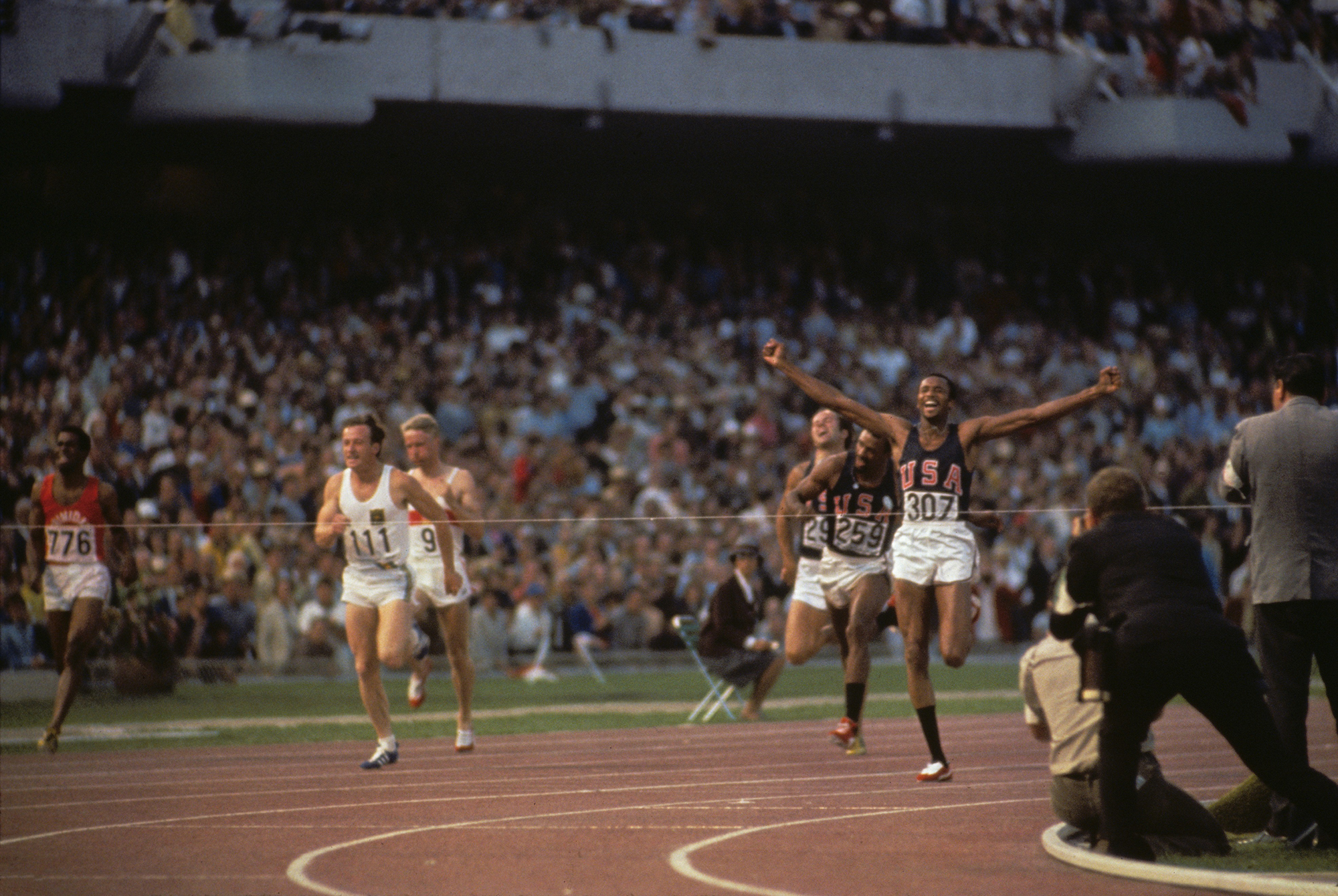
Smith started from lane 3, with Carlos in lane 4. These were the first Olympic track races on an artificial surface rather than on cinders or on dirt. Smith ran a cautious turn, protecting his groin injury; Carlos, the more powerful sprinter, scorched the bend, swallowed up the stagger on the third U.S. starter, Larry Questad, and reached the straightaway with a one-meter lead over Smith. “I was in trouble,” says Smith. “I was way behind the fastest man in the world.” But with 80 meters to run, Smith burst forward and delivered 60 meters that are among the fastest by any human. Carlos turned to look as Smith shot past (more on this). Smith was a breathtaking runner—knees lifting, shoulders slightly hunched, the rest of his body placid. Where Bolt was a fury of movement and power, Smith was serene.
Ten meters from the line, Smith raised his arms high and wide, then took his last seven strides that way. The automatic timer first froze at 19.78, and then was adjusted to 19.83. With Carlos’s previous mark disallowed, Smith’s time became the world record, and it stood for 11 years, and there’s little doubt he left time on the track by prematurely celebrating. Carlos, staggering at the line, lost the silver to Norman but comfortably took the bronze. Soon afterward came the medal ceremony. The gloves. The socks. The moment.
In the years that followed, Smith and Carlos would be seen as twins in a reductive narrative: tall black men with goatees, fast runners, militants. They were painted with the broadest of brushes and turned into caricatures of the angry black man, reviled and feared by many. The reality was different: Aside from being two of the fastest runners on earth, they had little else in common.
Smith was born in Clarksville, Texas, the seventh of 12 children; his family came to California on a labor bus when he was seven. They settled in -Lemoore, worked in the fields and went to church on Sundays. Tommie was serious, thoughtful, pious. Lynda Huey arrived at San Jose State two years after Smith, a blonde sprinter raised in San Jose. They dated for a while and later became close friends before drifting apart in the 1990s. “When I met Tommie,” says Huey, “he was very aware of his place in society. He didn’t think we should be seen together, a black man and a white girl. He would leave the apartment first, and tell me to wait 15 minutes.”
Smith’s track career was a runaway success. At one time he concurrently held world records for 200 meters, 220 yards and 400 meters. And if he was quiet, he was not unaware. In 1966, on the day that he set records in the 200 and the 220, he participated in a civil rights march in East Palo Alto. “I was a college student,” says Smith. “I was no dummy. And I knew racism.”
SMITH AND CARLOS WERE TURNED INTO THE CARICATURES OF THE ANGRY BLACK MAN. BUT ASIDE FROM BEING TWO OF THE FASTEST MEN ON EARTH, THEY HAD LITTLE ELSE IN COMMON.
Carlos was born one day short of a year after Smith and hardened by realities that only New York City can confer. In his 2011 autobiography, The John Carlos Story: The Sports Moment That Changed the World, written with Dave Zirin, he describes his childhood as a frenetic hustle, whether stealing food off freight trains (and giving it to poor families), playing the numbers for money or singing with his friends outside the Savoy Ballroom. His life and Smith’s were different versions of black men growing up in 1950s and ’60s America.
Carlos earned a track scholarship to East Texas State, spent two years there and then moved home before transferring out West in 1968. Carlos wrote in his book that it was Edwards who had encouraged the move at a meeting in New York City in January ’68, where Carlos says he also met Dr. King. Says Edwards, “I didn’t know, or know of, John Carlos prior to him showing up at San Jose State in May 1968. He quickly became one of the most ardent and vociferous advocates of the OPHR. Carlos came on board in May 1968—four months before the Olympic trials at Lake Tahoe—and I’m glad he did.”
The arrival of Carlos changed the atmosphere at San Jose State, which was already known as Speed City. “It had been Tommie’s kingdom,” says Huey. “Then John came, and the energy was different. John’s personality could be scary. And Tommie didn’t want to be a part of that. I don’t think they were ever friends.”
Carlos was the archetype of the trash-talking, big-stoned sprinter. In a 1991 retrospective, SI’s Kenny Moore, who was a marathoner on the 1968 and ’72 Olympic teams, called Carlos “a fountain of jive.”
Dick Fosbury, the gold medalist in the high jump at the ’68 Games, became friends with Carlos and Smith at Team USA training camps that summer. “John Carlos was a street-smart, very confident, fun guy to be around,” says Fosbury. “He had a walk, this strut, the way he carried himself. I was from small-town Oregon. I had never known anybody like ’Los. He struck me as a smart guy who could handle himself and any situation that came up. Tommie was thoughtful and a gentleman. They were different guys whose paths crossed.”
Their appearance on the stand remains riveting to this day, every element significant. Single shoes and bare feet covered only in black socks, signifying poverty at home. Carlos’s beads, recalling the lynchings of black men. Smith’s black scarf, highlighting a deep identity with his race. The gloves, the fists shoved upward for the world to see, suggesting defiance and unity.
Edwards watched from an apartment in Montreal. He started the movement, but he takes no credit for the moment. “That was them,” he says. “I didn’t know what they were going to do. They had a monumental thing in front of them. First, somebody had to win. Then they had to wrestle with the whole issue of what to do. There was no clear path, no silver staircase. The scope of the demonstration: the beads, the shoes, the gloves. The courage and the commitment that they showed. They deserve every accolade that they get. They deserve to be the faces of a movement that defined an era.”
Smith and Carlos knew they would protest somehow; they just weren’t sure what form it would take. They have never publicly agreed on who devised the specifics, but they agree that it came together only after the race, in the well of the stadium. “In the dungeon,” says Smith. Smith’s wife, Denise, had bought a pair of black gloves (Smith wore the right, Carlos the left). Carlos’s wife, Kim, had brought beads with her from the U.S. Over the years each man has taken credit for orchestrating the moment. And again, the outcome overwhelms the details. In the end, they were together.
At the first notes of the anthem, both men turned 90 degrees to the right and struck their poses. Carlos has said that his arm was bent to shield his face from sniper fire, Smith that his posture was ramrod straight as a remnant of his ROTC training. Smith told me, “I was afraid the whole time. I prayed. I said the Lord’s Prayer all the way through. Then I listened to the national anthem, because that’s a powerful thing, hearing that anthem knowing how many people died so that belief could remain a part of America.”
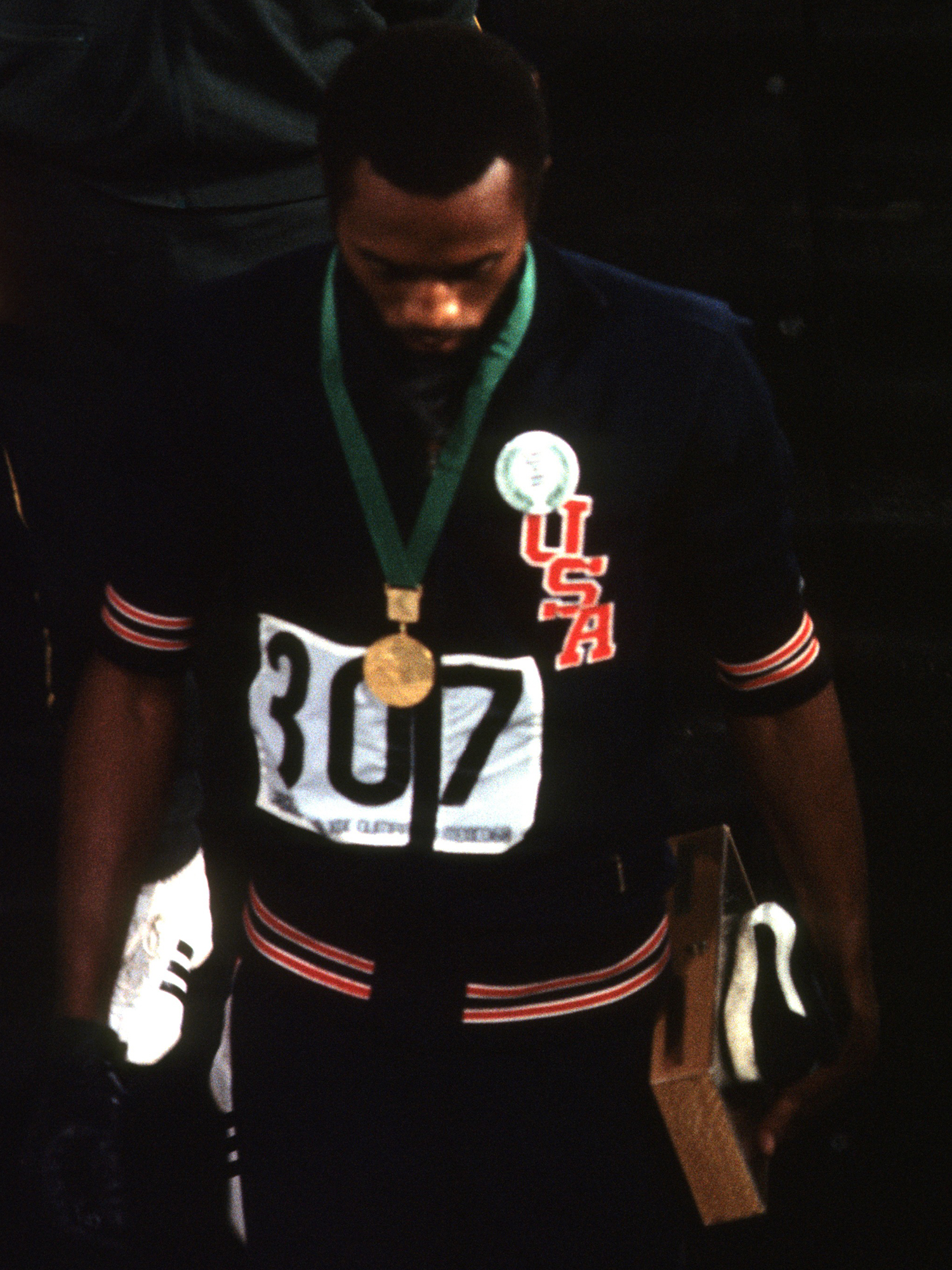
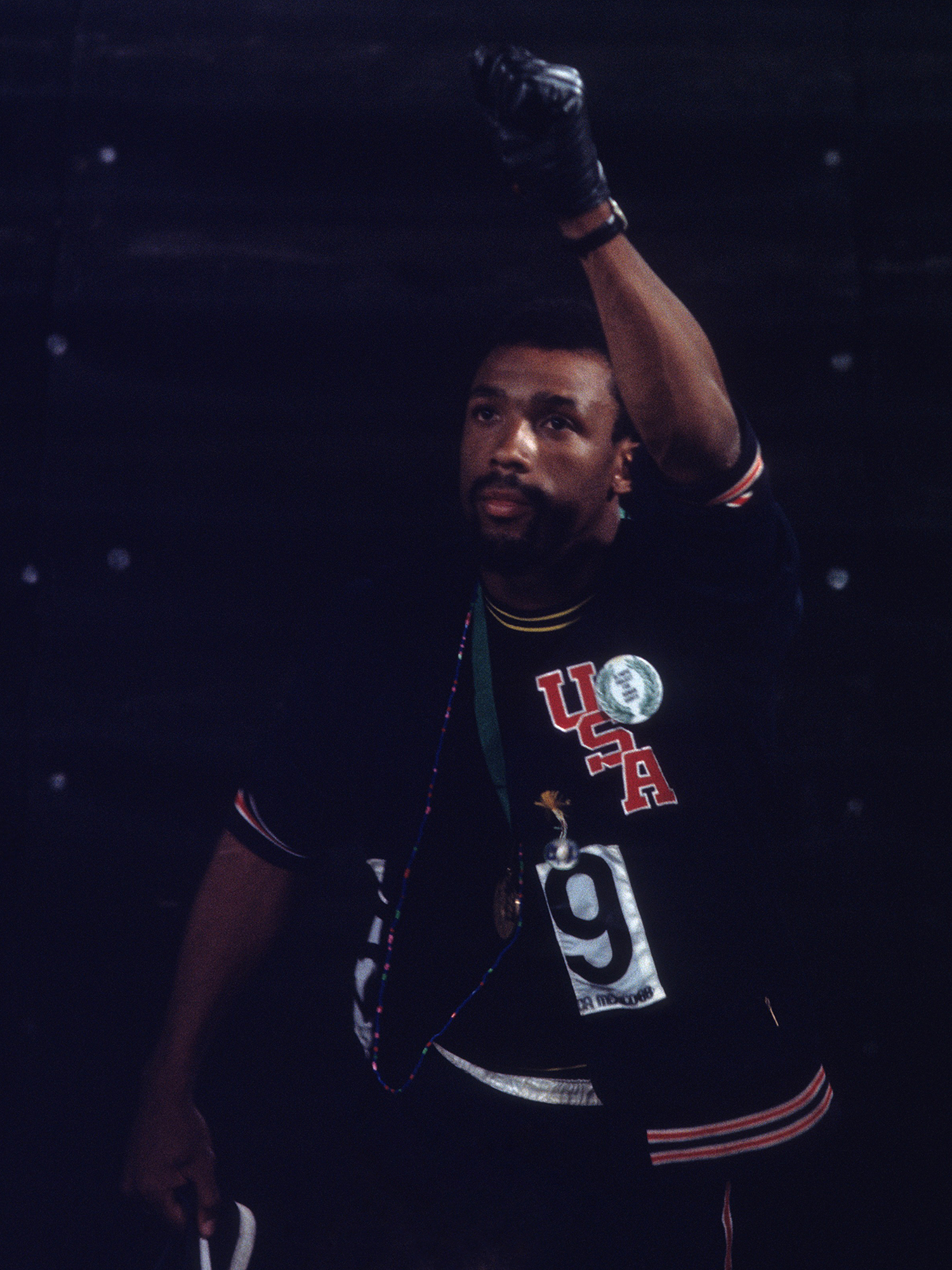
All three men wore OPHR pins; Norman’s had been given to him by a U.S. rower who supported the organization. The ceremony was over in less than 90 seconds. Smith and Carlos raised their fists as they left the stadium floor. Both men remember hearing boos and whistles.
Reaction at home was swift and mostly negative. The most frequently cited response came from Brent Musburger, then a 29-year-old sportswriter with the long-shuttered Chicago American, who wrote, “Smith and Carlos looked like a couple of black-skinned storm troopers, holding aloft their black-gloved hands during the playing of the national anthem.” Most media accounts found a way to use the term black power, which was fair—Edwards calls it a -“proto-hashtag”—but simplistic.
The BBC interviewed Smith and Carlos the next day.
BBC: “Do you think the Olympic Games are the right place to do this kind of thing? To use the world stage?”
Smith: “We used it so the whole world could see the poverty of the black man in America.”
BBC: “You might say you’ve got it all. You’ve got publicity, you’ve got medals, you’ve got martyrdom as well.”
Carlos: “I can’t eat that. And the kids around my block, that grew up with me, they can’t eat that. And the kids that grew up after them, they can’t eat it. They can’t eat gold medals. Like Tommie Smith said, ‘All we’re asking for is an equal chance.’ ”
Later that day Smith sat down with ABC’s Howard Cosell for a brief live interview. It is Cosell’s last question, and Smith’s answer, that lives on.
Cosell: “Are you proud to be an American?”
Smith: “I’m proud to be a black American.”
Fifty years later Smith sits in his basement and remembers the exchange. “That question stopped me,” he says. “I didn’t want to say, ‘Yes, Howard,’ because I was not proud at that particular time. I was confused about how to respond. So I said I’m proud to be a black American. I felt a light go through my body when I said that.”
On Friday, Smith and Carlos were suspended by the USOC (though they were done competing) after the IOC threatened to suspend the entire U.S. team if Smith and Carlos were not expelled. The two were ordered to leave the Olympic Village. The front-page headline in The New York Times: 2 black power advocates ousted from olympics. That night Evans led a U.S. sweep of the 400; all three men wore black berets on the victory stand, but removed them for the anthem. Long jumper Ralph Boston, who won a bronze medal behind teammate Bob Beamon’s ethereal world record, received his medal in bare feet. The Times wrote that their behavior had been “tempered” by the expulsion of Smith and Carlos. No one else was sent home.
There is one other issue relating to the 200-meter race in Mexico City: Carlos says he allowed Smith to win. He first hinted at this in the press conference afterward. Asked why he looked to his left, Carlos said, “The upper part of my calves were pulling pretty hard. I wanted to see where Tommie was and if he could win it. If I thought he couldn’t have won it, I would have tried harder to take it.”
By 2011, when Carlos wrote his book, that had evolved into, “Whatever drove Tommie, I could tell that for him, the only acceptable ending was to make his political statement from the gold medal perch and the gold medal perch alone. As for me, I didn’t care a lick if I won the gold, silver or bronze. I wasn’t there for the race. I was there for the after race.” In his interview for an NBC documentary, 1968, which will air this month, Carlos went further and called Smith’s injury “Fake. Artificial. He didn’t fool me in the least little bit.”
There is a long tradition of head games among sprinters. Perhaps Carlos truly settled for any medal that would get him onto the podium. But his insistence on this narrative has deepened the rift between the two. “John says he let me win,” says Smith. “Threw the race. You cannot say that. When you don’t win, you congratulate the winner for trying his best. I don’t believe Carlos means it. I really don’t.”
In the fall of 2017, Smith met with Kaepernick at a hotel restaurant in New York City. The meeting had been arranged by Glenn Kaino, an artist and documentary filmmaker who is working with Smith. “I told him he will have to find new avenues for his life,” says Smith. “He’ll need a second plan. I had a plan for my life before Mexico City. But that stopped it. I got home and I was hungry. I lost my food. I lost my house. The price was devastating.”
There is a distinction here: Kaepernick’s protest has cost him millions, but he has also made millions. And his new contract with Nike figures to generate significant income. His future is sure to be very different from the one Smith and Carlos have lived. Says Edwards, “Not only is Kaep likely to make millions from his Nike deal, he is also likely to receive every dollar that he would have made on the field by way of a settlement with the league without taking another hit.” (The resolution of his collusion claim against the league is pending.) Edwards adds, “On top of it all, he will continue to grow as a sports icon, who will be remembered and revered by tens of millions after all but the most diehard football heads will have long forgotten the likes of Brady, Favre and Manning.” The scope of Kaepernick’s legacy is debatable, as Smith and Carlos will attest, but there are differences between a sprinter and a quarterback.
The question of whether their protest was worth it will always hang over Smith and Carlos. It did not instantly alter the course of race relations in America. Edwards argues that the path set upon by Smith and Carlos was never going to be a straight line to equality. “Struggles that are not victories do generate change,” says Edwards. “Whether or not they generate progress is another issue. -Progress is like profit; at some point it comes down to who’s keeping the books.” Edwards divides athlete activism into waves: Jack Johnson and Jesse Owens (among others) fighting for legitimacy in the first; Jackie Robinson and Larry Doby (among others) fighting for access in the second; Muhammad Ali, Jim Brown, Kareem Abdul-Jabbar, Bill Russell and Smith and Carlos (and others) fighting for dignity in the third. And Kaepernick (and others including Malcolm Jenkins and Eric Reid) are the evolving fourth wave.
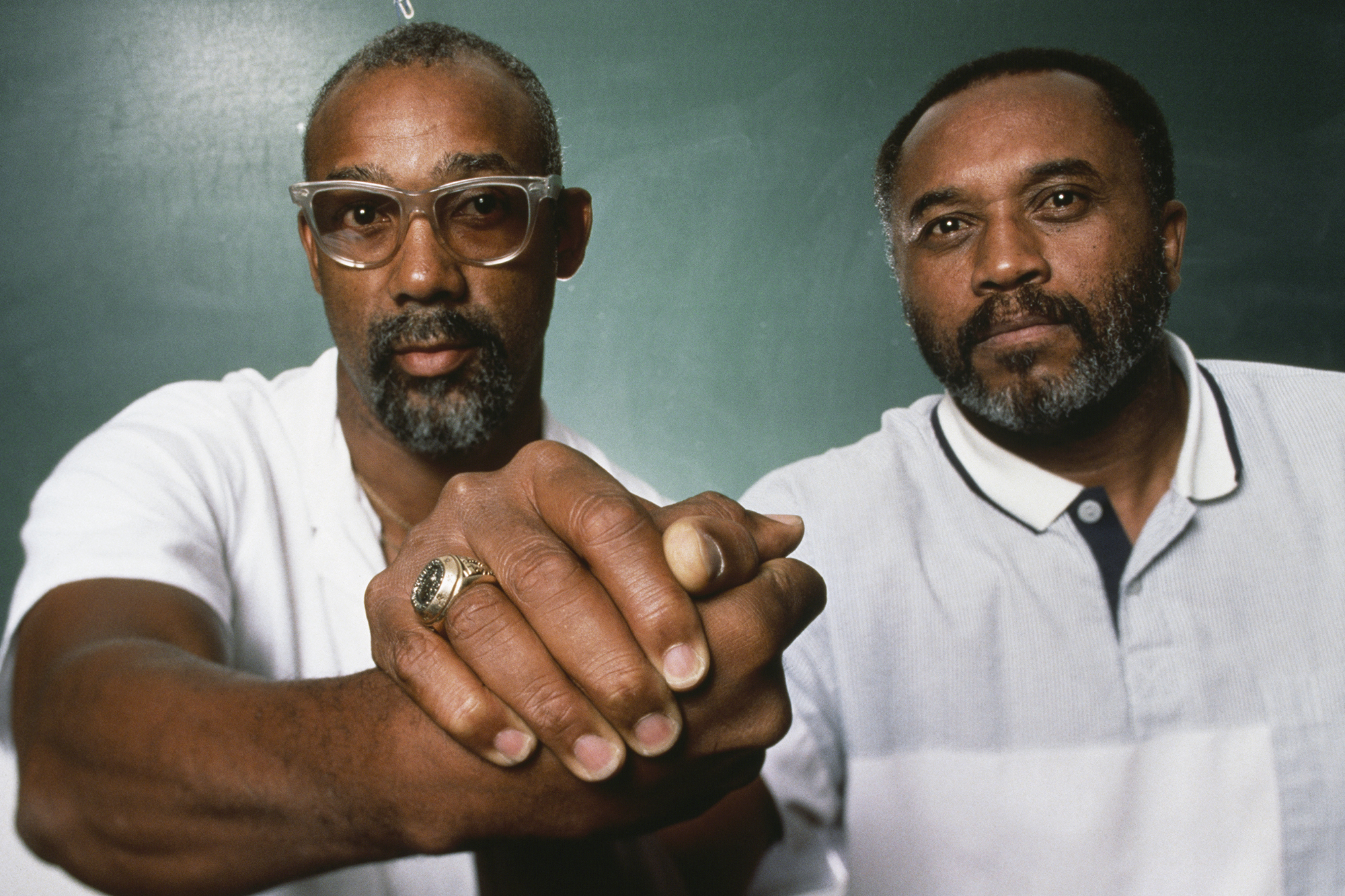
What did Smith and Carlos contribute most? “Imaging,” says Edwards. “Those two men on a victory podium in Mexico City is the most iconic sports image of the 20th century, and that will still be true 200 years from now.”
But to paraphrase Carlos, you can’t eat imaging. Both men suffered for their protest, drifting in and out of poverty; Smith for several years and Carlos for large slices of three decades. Not long after Smith returned home from Mexico City, his mother’s home was vandalized, with feces left in the mailbox and dead animals on the lawn. Both men played pro football—Smith played two regular season games for the Cincinnati Bengals and caught one pass for 41 yards, while Carlos never made it out of training camp.
Smith caught a break in 1972, when activist Jack Scott was named athletic director at Oberlin (Ohio) College and hired three black head coaches, including Smith. Smith worked at Oberlin for six years, until he was hired as a coach and phys-ed teacher at Santa Monica, a community college. Smith stayed there for 27 years, speaking out mostly when spoken to. Huey recalls walking down the hall with Smith in the late ’80s, hearing a young student heave a little trash talk at him and Smith saying, softly, “They have no idea.” Mexico City was always a part of his life. “I don’t remember ever not knowing about it,” says Kevin Smith, 50, who was born to Tommie and Denise a few months before the ’68 Olympics.
But Smith found traction at Santa Monica. “He was quiet, humble, analytical,” says Jeff Shimizu, who worked at the college from 1985 to 2016, mostly as executive vice president. “I felt he was happy here, but he had been through difficult times. He was a strong advocate for diversity, and he loved working with students. I loved going into his office and talking. I miss him.”
Reentry was more challenging for Carlos. After a few races in the aspirational and short-lived International Track Association (a fledgling pro track league in the era of “amateurism”), he moved to Los Angeles with Kim and their three children in the early 1970s. There, as he describes in his book, he found work as a security guard and a groundskeeper at a park. He told SI in ’91 that he once worked as a bar bouncer for $65 a week. He wrote of burning furniture in the fireplace for heat. Says Kimme, “There were struggles, but what I remember most is seeing my father get up and go to work every day, no matter what the job was. We had a roof over our heads. We had food. I saw a man of integrity.”
Kim died by suicide in 1977, four years after the couple had split. Carlos has long blamed himself and the backlash from Mexico City for her death. But Kimme, a mental health counselor in Trenton, N.J., has pushed back against that narrative. “Suicide is much more complicated than that,” she says. “My mother was a woman of color in the ’60s and ’70s. You did not discuss mental illness. You did not discuss whatever pain you were dealing with. The demonstration [in Mexico City] didn’t make our lives easier. But any decision my mother made had nothing to do with my father.”
In 1984, Carlos was hired by the L.A. Olympic Organizing Committee and spent the year working in youth programs. After that he backslid again, including an arrest in ’86 for cocaine possession. (He was found guilty, but after he attended an interventional program, the conviction was expunged from his record.) In 1990, at 45, he was hired by Palm Springs (Calif.) High as a counselor and track coach. He spent 24 years at the school and became revered for his ability to connect with some of the most at-risk students in the community. “John doesn’t tolerate any b-------,” says Ricky Wright, a former college athlete who was the principal for most of Carlos’s time there. “He did not pull punches. He loved those kids, and he changed lives.”
Paul Grafton, the vice principal of student affairs at Palm Springs High who hired Carlos, says, “There’s a point where a kid makes excuses before he tells the truth, if he ever tells the truth. John was able to get kids very quickly from excuses to truth.”
Retirement for Smith and Carlos does not snuff out the fundamental question: Would they do it again? They set a course for their lives on that night in Mexico City. They were inarguably heroic (if you think they were something else as well, that is fine, but do not deny them their heroism), but that came at a cost. Still, neither man will look back and question himself because the act endures as inspiration, powerful beyond words.
Says Carlos, “Would I do it again? Absolutely! Yes! When the time came, when I had my one chance in life, I stood up and said, ‘This s--- is wrong. It’s got to be corrected.’ ”
But now? “The present is not frustrating to me, man. My time was fifty years ago. That’s over. Young people today, they need to turn up the volume. They need to come together.”
Smith cannot imagine his life without the protest. “It was not a matter of whether I wanted to do it,” he says. “I had to do it. My father had a saying: ‘When you could, you wouldn’t. Now you want to, but you can’t.’ I was standing on the highest platform in the world. How could I not?”
In his basement, surrounded by history, I ask Smith if there is anyone he would like to talk to about all this, a kindred soul who might understand the struggle and the wounds, the stubbornness of progress and the evil of hate. Smith nods slowly, turns to face me and offers the slightest hint of a shrug. His answer: “John.”
